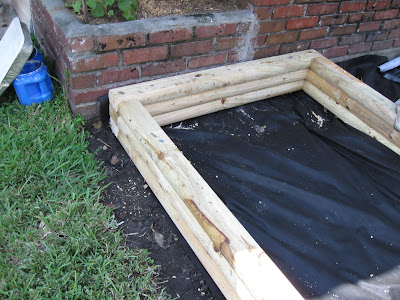Why did I go with the landscape fabric and not the cardboard, or newspapers, a popular choice in building raised beds? I did not want to give crabgrass and Bermuda grass any chance of surviving; and these two are my biggest enemies in the garden. Granted, the package said that "no landscape fabric will stop Bermuda grass and crabgrass", as it grows even through asphalt, but I am taking my chances because the fabric will be covered with a foot of soil, and secondly, I have a row of raised beds that is built on top of the grass, and it survived just fine, even being only six inches tall. The only problem with this bed is that the grass creeps in through the sides; the problem that I am hoping to overcome by having the bare barrier around this new bed.
After the fabric was laid, the bed construction has begun. I am building this garden from landscape timbers so it will last a long time and not cost too much money.
The timbers are laid on the edge of the cut area where the sod was taken out, but leaving at least a six inch strip of bare land all around the bed area.
I am making my beds three timbers high, which will give me nine inches of height from the ground. From there, I plan on filling the beds with soil, tapering three inches over the edge of the bed, which will give me a total of a foot of growing depth. This depth will be totally sufficient for most vegetables, including tomatoes, peppers, short carrots, all kinds of greens, like kale or lettuce, all herbs, cucumbers, beans, beets, and so on. The only vegetables that might need a deeper soil would be squash, daikon radish, and maybe the vegetables that need deep sturdy staking (as I cannot drive stakes through the landscape fabric). All in all, looks like I can grow practically anything in these beds.
And here we are, first bed is complete. I chose to go with an L-shape to make the square area more interesting, as well as space-saving.
It took two men three hours to build this bed. They used heavy duty landscape nails to connect the timbers together.
So far, the cost of material is $36 in landscape fabric (I picked up two tubes of 3x100 at Walmart).
I already bought the timbers, nails, and paving stones, but do not know at this point how much of these will be used to build this garden space. Will calculate when the beds are complete.
You might also be interested in:
How to build a garden Part 1
Double-digging garden beds
Vegetable yields per plant














Wow your garden is really looking good!! Looking forward to pics as things begin to grow. It may seem like a lot of money at first but it is more of an investment than anything. All the good highly nutritious food you get in return easily pays for the initial cost in a short amount of time.
ReplyDeleteAmen!
ReplyDeleteI already see the benefits. It has been raining like crazy here lately, but little seedlings survived the flooding just fine in these raised beds because of improved drainage.